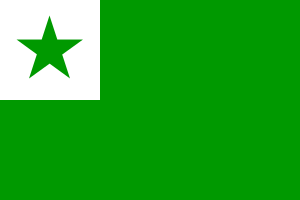Outline of Esperanto
The following outline is provided as an overview of and topical guide to Esperanto:

Esperanto[1][2] is the most widely spoken constructed international auxiliary language. L. L. Zamenhof, a Polish-Jewish ophthalmologist, created Esperanto in the late 19th century and published the first book detailing it, Unua Libro, in 1887 under the pseudonym Dr. Esperanto, Esperanto translating as "one who hopes".[3]
What type of thing is Esperanto?
Esperanto can be described as all of the following:
Branches of Esperanto
History of Esperanto
General Esperanto concepts
- Grammar
- Phonology
- Orthography
- Braille
- Vocabulary
- Etymology
- Ĉ
- Ĝ
- Ĥ
- Ĵ
- Ŝ
- Ŭ
- Special Esperanto adverbs
- Interrogatives in Esperanto
- Esperanto words with the infix -um-
- Esperanto profanity
- Comparison between Esperanto and Ido
- Comparison between Esperanto and Interlingua
- Comparison between Esperanto and Novial
- Gender reform in Esperanto
Esperanto organizations
- List of Esperanto organizations
- World Esperanto Congress
- Akademio de Esperanto
- Universal Esperanto Association
- World Esperanto Youth Organization
- International Youth Congress
- European Youth Week
- World Anational Association
- Encyclopedia
- Pasporta Servo
- Plouézec Meetings
- European Esperanto Union
- Europe–Democracy–Esperanto
- Panamerican Congress
- Skolta Esperanto Ligo
Presidents of Universal Esperanto Association
Additional Esperanto organizations
- Esperanto club
- International League of Esperantist Radio Amateurs
- Akademio de Esperanto
- Akademio Literatura de Esperanto
- Amikeca Reto
- Arbeidernes Esperantoforbund
- Association of Green Esperantists
- Bahá'í Esperanto-League
- Buenos Aires Esperanto Association
- Distributed Language Translation
- E@I
- Esperantic Studies Foundation
- Esperanto Museum and Collection of Planned Languages
- Europe–Democracy–Esperanto
- European Esperanto Union
- Guvernanta Sonorilo Esperanto
- Icelandic Esperanto Association
- Indigenous Dialogues
- Indonesian Esperanto Association
- International Esperanto League
- International League of Christian Esperantists
- International League of Esperanto Teachers
- International Union of Catholic Esperantists
- Iranian Esperanto Association
- Junularo Esperantista Brita
- Mondpaca Esperantista Movado
- Pasporta Servo
- Plouézec International Meetings
- President of the Universal Esperanto Association
- Quebec Esperanto Society
- SATEB
- Sennacieca Asocio Tutmonda
- Skolta Esperanto Ligo
- Terminologia Esperanto-Centro
- Universal Esperanto Association
- World Esperantist Vegetarian Association
- World Esperanto Youth Organization
National Esperanto organizations
- Australian Esperanto Association
- Esperanto Association of Britain
- Canadian Esperanto Association
- Croatian Esperanto League
- Esperanto in Malaysia
- Iranian Esperanto Association
- New Zealand Esperanto Association
- Norvega Esperantista Ligo
- Taiwan Esperanto Association
- Esperanto-USA
Esperanto meetings
- Conference on the Application of Esperanto in Science and Technology
- Esperanto Youth Week
- FESTO (Esperanto meeting)
- Internacia Junulara Festivalo
- Internaciaj Floraj Ludoj
- International Youth Congress
- Panamerican Esperanto Congress
- Semajno de Kulturo Internacia
- Summer Esperanto Study
- World Esperanto Congress
Esperanto ideas
Esperanto publications
Dictionaries
- Komputeko
- Pekoteko
- Plena Ilustrita Vortaro de Esperanto
- Plena Manlibro de Esperanta Gramatiko
- Plena Vortaro de Esperanto
- Reta Vortaro
- La Vortaro
- Vortaro de Esperanto
Encyclopedias
Esperanto literature
Esperanto novels
- Abismoj
- Children of Orpheus
- Gerda malaperis!
- Kazohinia
- Kredu min, sinjorino!
- Metro (novel)
- Mr. Tot Aĉetas Mil Okulojn
- Saltego trans Jarmiloj
- Tur-Strato 4
- Voyage to Faremido
Esperanto media
Esperanto magazines
Historical publications
- Amikeca Reto
- Bible translations into Esperanto
- Der Esperantist
- La Esperantisto
- Lingvo Internacia (periodical)
- Plena Ilustrita Vortaro de Esperanto
- Xin Shiji
Persons influential in Esperanto
Esperanto education
- International Academy of Sciences San Marino
- Bona Espero
- International League of Esperanto Teachers
- Kurso de Esperanto
- Lernu!
- North American Summer Esperanto Institute
- Propaedeutic value of Esperanto
- Summer Esperanto Study
- Wedgwood Memorial College
See also
References
- ^ Jones, Daniel (2003) [1917], Peter Roach; James Hartmann; Jane Setter (eds.), English Pronouncing Dictionary, Cambridge: Cambridge University Press, ISBN 3-12-539683-2
- ^ Wells, John C. (2008), Longman Pronunciation Dictionary (3rd ed.), Longman, ISBN 978-1-4058-8118-0
- ^ "Doktoro Esperanto, Ludwik Lejzer Zamenhof". Global Britannica.com. Encyclopædia Britannica Inc.
